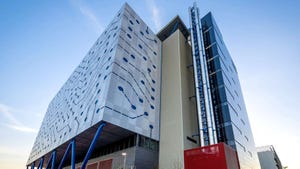Why Water Cooling In Data Centers Is Not Always SustainableWhy Water Cooling In Data Centers Is Not Always Sustainable
Here's how 'water-free' cooling in data centers works, why it's sometimes more efficient than air and liquid cooling, and how to decide if it's the best strategy for your data center.

One of the conventional tenets of data center sustainability is that water cooling is better than air cooling. The reason why is simple: Liquid cooling is more efficient, so it uses less energy to deliver the same cooling capacity.
That's true – except when it's not. In some cases, a method known as water-free cooling, which uses minimal amounts of water, may actually be the more sustainable way to dissipate heat from equipment inside data centers.
Here's how sustainable data center cooling without water works, why it's sometimes more efficient and how to decide if water-free cooling is the best strategy for your data center.
The Basics of Data Center Cooling
There are three common ways to cool equipment inside data centers:
Blowing air across equipment to dissipate heat. This is the most straightforward way to cool a data center, but it's the least efficient because air is much less effective than water for dissipating heat.
Circulating water in close proximity to equipment to dissipate heat. This is far more efficient than air cooling, but also more expensive to implement.
Immersing equipment in non-conductive liquid – a practice known as immersion cooling. This is the most efficient, but also most expensive, way to cool a data center.
If you're looking for a middle ground between cost and efficiency, you might opt for water cooling.
The Sustainability Impact of Water Cooling
From a sustainability perspective, water cooling's main advantage is that it uses less energy than air cooling to reduce temperatures by a similar amount. This translates to lower overall electricity consumption – which in turn means that data centers with water cooling systems can often claim to be greener than those that rely on traditional air cooling.
Viewed from another angle, however, water cooling is not very sustainable for data centers located in regions with limited water availability.
The key factor to understand here is that most or all of the water used for water cooling is typically discharged outside the data center. In other words, it's used only one time without being recirculated.
As a result, data centers that rely on water cooling must constantly ingest water to maintain acceptable temperature levels. The volume of water can be very significant. For instance, Google says its data centers consume about 450,000 gallons of water each day per facility – an amount equivalent to the daily water consumption of about 1,500 homes.
This might not be an issue if your data center is located in a region with abundant water. But if water is in short supply, conventional water cooling may not be very sustainable. It could deprive the surrounding natural environment of sufficient quantities of water and/or compete with local communities for water.
This problem, unfortunately, is likely only to grow worse as groundwater availability continues to decrease in many areas.
Alternatives to Water Cooling
Faced with this challenge, data center operators have a few choices.
One is to opt for air cooling, but that comes with its own sustainability impact. Unless you can source renewable energy to power your air cooling systems, you'll essentially just be trading a poor Water Usage Effectiveness (WUE) metric for subpar Power Usage Effectiveness (PUE).
Another is to upgrade to immersion cooling. But again, that's very pricey, and is not within the budget of all data center facilities.
A third option is to adopt a modified form of water cooling, known as water-free or zero-water cooling. These terms refer to systems that recirculate water through a loop, enabling water-based cooling with minimal water usage. (Despite the terms "water-free" or "zero-water," there is still a small amount of water in use – but it's a fraction of the quantity employed by traditional water cooling systems.)
The savings can be dramatic. For example, Wes Swenson, CEO of Novva Data Centers, told Data Center Knowledge that by installing water-free cooling at one 400,000 square-foot facility, his company reduced water usage to just several thousand gallons per day – the bulk of which was consumed by the facility's employees, not its cooling systems. Novva's cooling system requires 10,000 gallons to fill, and once filled, the water can be reused for an extended period.
Swenson added that this operation also reduces the stress placed on municipal water systems because it significantly reduces the amount of gray water discharged from the facility. In addition, it indirectly reduces energy use because less energy is necessary to clean discharged water.
Conclusion: Will Water Cooling Always Look So Green?
In regions where water availability is not a concern, traditional water or liquid cooling for data centers is likely to remain the go-to approach. But as more and more communities face water shortages, traditional water cooling will cease to look so green – and finding ways to achieve the efficiency of water cooling without consuming vast quantities of water will become more and more critical for data center sustainability.
About the Author
You May Also Like









